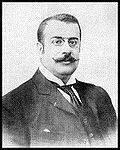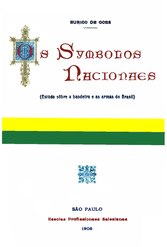File:Os symbolos nacionaes.pdf

Original file (1,029 × 1,443 pixels, file size: 26.99 MB, MIME type: application/pdf, 326 pages)
Captions
Captions
| Eurico de Góis: Q51882626
|
|||||||||||||||||||||||||||||||||||||||
|---|---|---|---|---|---|---|---|---|---|---|---|---|---|---|---|---|---|---|---|---|---|---|---|---|---|---|---|---|---|---|---|---|---|---|---|---|---|---|---|
| Author |
author QS:P50,Q10278276
author QS:P50,Q10270749 |
||||||||||||||||||||||||||||||||||||||
| Title |
Os symbolos nacionaes |
||||||||||||||||||||||||||||||||||||||
| Publisher |
Escolas Profissionaes Salesianas |
||||||||||||||||||||||||||||||||||||||
| Object type |
literary work / version, edition or translation |
||||||||||||||||||||||||||||||||||||||
| Language | Portuguese | ||||||||||||||||||||||||||||||||||||||
| Publication date |
1908 publication_date QS:P577,+1908-00-00T00:00:00Z/9 |
||||||||||||||||||||||||||||||||||||||
| Place of publication | São Paulo | ||||||||||||||||||||||||||||||||||||||
| Authority file | |||||||||||||||||||||||||||||||||||||||
| Source | Google Books , Google Books | ||||||||||||||||||||||||||||||||||||||
| Permission (Reusing this file) |
|
||||||||||||||||||||||||||||||||||||||
This file is in PDF format.
Portable Document Format (PDF) is a file format created by Adobe Systems for document exchange. PDF is used for representing two-dimensional documents in a manner independent of the application software, hardware, and operating system. Each PDF file encapsulates a complete description of a fixed-layout 2D document that includes the text, fonts, images, and 2D vector graphics which compose the documents. The best way to view PDF files is locally using a reader.Several free readers for every system are available at pdfreaders.org. Deutsch | English | español | français | македонски | Nederlands | português | русский | +/−
|
File history
Click on a date/time to view the file as it appeared at that time.
| Date/Time | Thumbnail | Dimensions | User | Comment | |
|---|---|---|---|---|---|
| current | 03:13, 18 December 2020 |  | 1,029 × 1,443, 326 pages (26.99 MB) | Giro720 (talk | contribs) | +ocr layer, better colors |
| 04:06, 25 January 2011 | No thumbnail | 0 × 0 (7.1 MB) | Erasmus Roterodamus (talk | contribs) | {{Information |Description= ''Os symbolos nacionaes'' / Eurico de Góes, Eduardo Prado. São Paulo: Escolas Profissionaes Salesianas. 1908. |Source=[http://books.google.com/books?id=0GgCAAAAYAAJ Google Books] [http://books.google.com/books?id=vyY9AQAAIAAJ |
You cannot overwrite this file.
File usage on Commons
The following 5 pages use this file:
File usage on other wikis
The following other wikis use this file:
- Usage on pt.wikipedia.org
- Usage on pt.wikisource.org
- Galeria:Os symbolos nacionaes.pdf
- Página:Os symbolos nacionaes.pdf/1
- Página:Os symbolos nacionaes.pdf/2
- Página:Os symbolos nacionaes.pdf/3
- Página:Os symbolos nacionaes.pdf/4
- Página:Os symbolos nacionaes.pdf/5
- Página:Os symbolos nacionaes.pdf/6
- Página:Os symbolos nacionaes.pdf/7
- Página:Os symbolos nacionaes.pdf/8
- Página:Os symbolos nacionaes.pdf/13
- Página:Os symbolos nacionaes.pdf/10
- Página:Os symbolos nacionaes.pdf/12
- Página:Os symbolos nacionaes.pdf/11
- Página:Os symbolos nacionaes.pdf/14
- Página:Os symbolos nacionaes.pdf/16
- Página:Os symbolos nacionaes.pdf/15
- Página:Os symbolos nacionaes.pdf/17
- Página:Os symbolos nacionaes.pdf/328
- Página:Os symbolos nacionaes.pdf/327
- Página:Os symbolos nacionaes.pdf/326
- Página:Os symbolos nacionaes.pdf/325
- Página:Os symbolos nacionaes.pdf/324
- Página:Os symbolos nacionaes.pdf/323
- Página:Os symbolos nacionaes.pdf/322
- Página:Os symbolos nacionaes.pdf/321
- Página:Os symbolos nacionaes.pdf/320
- Página:Os symbolos nacionaes.pdf/319
- Página:Os symbolos nacionaes.pdf/312
- Página:Os symbolos nacionaes.pdf/18
- Página:Os symbolos nacionaes.pdf/19
- Página:Os symbolos nacionaes.pdf/20
- Página:Os symbolos nacionaes.pdf/21
- Página:Os symbolos nacionaes.pdf/22
- Página:Os symbolos nacionaes.pdf/23
- Página:Os symbolos nacionaes.pdf/24
- Página:Os symbolos nacionaes.pdf/25
- Página:Os symbolos nacionaes.pdf/26
- Página:Os symbolos nacionaes.pdf/30
- Página:Os symbolos nacionaes.pdf/27
- Página:Os symbolos nacionaes.pdf/29
- Página:Os symbolos nacionaes.pdf/31
- Página:Os symbolos nacionaes.pdf/32
- Página:Os symbolos nacionaes.pdf/33
- Página:Os symbolos nacionaes.pdf/34
- Página:Os symbolos nacionaes.pdf/35
- Página:Os symbolos nacionaes.pdf/36
- Página:Os symbolos nacionaes.pdf/315
- Página:Os symbolos nacionaes.pdf/316
- Os symbolos nacionaes
View more global usage of this file.
Metadata
This file contains additional information such as Exif metadata which may have been added by the digital camera, scanner, or software program used to create or digitize it. If the file has been modified from its original state, some details such as the timestamp may not fully reflect those of the original file. The timestamp is only as accurate as the clock in the camera, and it may be completely wrong.
| Short title | Os symbolos nacionaes |
|---|---|
| Author | Eurico de Goes |
| Conversion program | Adobe Acrobat Pro DC 15 Paper Capture Plug-in |
| Encrypted | no |
| Page size |
|
| Version of PDF format | 1.6 |





